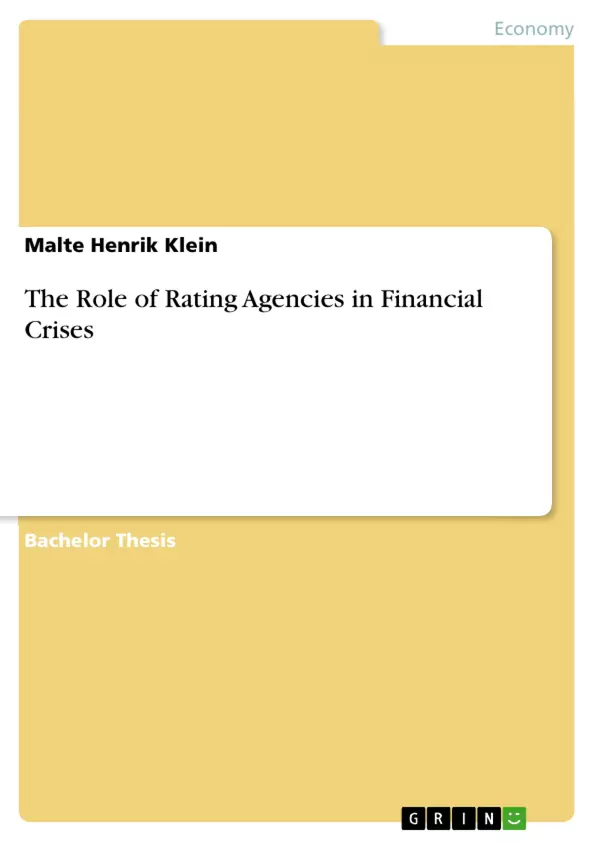To understand the roots of the capital markets and the rating agencies I want to start this Bachelor Thesis with a historical development. With introduction of the Issuer Pays Model and the proclamation of so called NRSROs there is the starting point for a long time discussion within the credit rating industry. Then I want to introduce the case of Enron, a former energy conglomerate which has been wrongly rated by the rating agencies.
I want to investigate if there are any parallels to the crisis of 2007. I also want to understand and show the reasons and the structure of the crisis of 2007. So I will introduce the Subprime market and structured finance, as these topics were probably the triggers for the crisis. The main part of my thesis is to find an explanation for the performance of the credit rating agencies. I use a theoretical model which stresses the complexity of assets. The model says that the more complex an asset is, the harder it is to rate for the agencies.
In opposite to that I want to compare the results of the theoretical model with an empirical study. I want to investigate if the theoretical model gets the same result as the empirical approach or if there are huge differences. At last I want to introduce some solution proposals by myself and think about further approaches.
Table of Contents
- Introduction
- Historical Development of the Rating Agencies and Recent Problems
- Years of Foundation
- The Issuer Pays Model
- Nationally Recognized Statistical Rating Organization
- Recent Rating Problems- The Case of Enron
- The Financial Crisis 2007 - ?
- Reasons
- The Subprime Market
- Structured Finance
- The Development
- The Role of the Rating Agencies- A Model trying to explain..……............
- Ratings Shopping and Asset Complexity
- List of Literature
- A Model of an Asset Auction and a Market for Ratings
- Mandatory Disclosure of Shadow Ratings.………………………….
- Voluntary Disclosure
- The Disclosure Decision
- The Acquisition Decision
- The Main Results of the Theoretical Model
- The complexity of assets raises the incentive to shop for ratings.....
- Complexity affecting ratings bias
- Issuer might prefer more complex assets.
- An Empirical Dispute
- Proposed Solutions and Further Perspectives .……………....
- Conclusion...........
Objectives and Key Themes
This thesis examines the behavior of credit rating agencies, particularly in the context of the financial crisis of 2007. The author seeks to understand the factors that influenced their actions and to explore the triggers and reasons behind their behavior.
- The historical development of credit rating agencies and the evolution of their practices.
- The impact of the "issuer pays" model on rating agency behavior and the potential for conflicts of interest.
- The role of rating agencies in the financial crisis, focusing on the issues of structured finance, subprime mortgages, and asset complexity.
- The concept of "ratings shopping" and its implications for the reliability of ratings.
- Potential solutions and perspectives on the future of credit rating agencies.
Chapter Summaries
- Introduction: The chapter introduces the topic of credit rating agencies and their significance in the financial world, highlighting their influence on markets and the potential for their recommendations to be inaccurate.
- Historical Development of the Rating Agencies and Recent Problems: This chapter provides a historical overview of the development of credit rating agencies, outlining their early years, the adoption of the "issuer pays" model, and the emergence of the concept of a Nationally Recognized Statistical Rating Organization (NRSRO). The chapter also addresses recent problems, specifically focusing on the Enron case.
- The Financial Crisis 2007 - ?: This chapter delves into the financial crisis of 2007, exploring its causes, including the subprime market and the development of structured finance.
- The Role of the Rating Agencies- A Model trying to explain..……............: This chapter examines the role of rating agencies in the financial crisis, focusing on a model that attempts to explain the observed behaviors. It discusses topics like "ratings shopping" and the impact of asset complexity on ratings. The chapter also includes a theoretical model exploring the relationship between asset complexity, ratings bias, and issuer preferences.
- Proposed Solutions and Further Perspectives .……………....: This chapter explores potential solutions to the problems associated with credit rating agencies and offers perspectives on the future of this industry.
Keywords
This thesis focuses on key concepts such as credit rating agencies, the "issuer pays" model, structured finance, asset complexity, "ratings shopping," and the financial crisis of 2007. It examines the potential for conflicts of interest within credit rating agencies and their role in the market.
- Citar trabajo
- Malte Henrik Klein (Autor), 2010, The Role of Rating Agencies in Financial Crises, Múnich, GRIN Verlag, https://www.grin.com/document/162621



